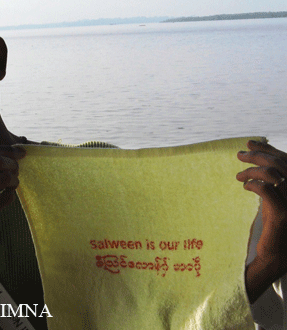Students who have learned about undisclosed plans by Burmese government to dam the Salween river, have made shirts and handkerchiefs bearing phrases to raise awareness on the subject in Salween River community.
Inscribed with the phrase “Salween Is our Life” in English and Mon, the students hope that by wearing and using these shirts they will get community members interested in the phrase, and what it means.
The group of over 10 Moulmein University (University of Mawlamyine) students from the lower Salween river area explained they’ve made these shirts and handkerchiefs to spread awareness about a yet officially undisclosed plan by the Burmese government State Peace and Development Council (SPDC), to begin construction on a series of dams along the Salween River.
 The leader of the 10 students, who is from the lower Salween River, on Belukyun Island, Moulmein Township, explained, “We do not agree with what the Burmese authorities [are] doing. So we’re sharing and showing the handkerchiefs on the ship from port at Kalawi village to Moulmein. We are not protesting – we [just] want the people who live like us downriver on the Salween to be educated [about this subject] – so we do like this.”
The leader of the 10 students, who is from the lower Salween River, on Belukyun Island, Moulmein Township, explained, “We do not agree with what the Burmese authorities [are] doing. So we’re sharing and showing the handkerchiefs on the ship from port at Kalawi village to Moulmein. We are not protesting – we [just] want the people who live like us downriver on the Salween to be educated [about this subject] – so we do like this.”
The group of Moulmein university students decided to share what hey had learned after attending a low-profile Salween River dam workshop put on by the Mon Youth Progressive Organization (MYPO).
According to Taing Pakao Mon who has spearheaded the MYPO education workshops on the Salween River dam projects, “If the dams are built, over half a million people who lives in downriver will meet with problems.”
“Most of the Mon who live downriver don’t know about the dam construction plans, or if they will meet with problems [when it’s completed]. So we give this educational workshop to monks and the university students,” Taing Pakao Mon explained, clarifying the MYPO goals in hosting the educational sessions. “After that the people who [then] know can go and make activities like that [“Salween is Our Life” project].”
Members of the MYPO, and organizations that have become familiar with the proposed dam construction project, say that it will cause widespread loss of basic rights.
A report released in 2007 by the MYPO, titled In The Balance, details the potential fall out on costal and river environments and communities. These knock on affects would include the disruption of river structure and land mass, household water usage for half a million people, agriculture, fragile fishing ecosystems, and the livelihoods of residents.
With a project of this size, another major concern is of the unexpected consequences of construction Taing Pakao Mon says. He points to the Salween Bridge as an example. Running from Mottama to Moulmein, after bridge was completed, the direction of the water’s flow was disrupted by the supporting columns of the bridge. The new flow pattern of the river hit the banks differently and caused them to collapse.
A villager from Zinkyaik village, Paung Township, explained that he attended the Salween River dam workshop to know how to prevent the Salween River from being dammed.
“I will share [what I learned] with people who live in my village and then if the authority will begin building to dam the Salween River, we will protest.”
Plans have been discussed in secret by the governments of Burma, Thailand and China for the construction of 4 damns to supply electricity to Burma and its investing countries. The first phase of the project would be the construction of the Hutgyi dam.
The proposed Hutgyi dam project would be 33 meters tall, and produce 1,360 megawatt of electricity, according to the Burma Rivers Network. The MYPO estimates that total, the 4 dams combined will produce 15,000 to 20,000 megawatts of electricity – 10 times what Burma currently consumes.
To target the partial source of funding for these construction projects, the Thailand-based environmental group, Towards Ecological Recovery and Regional Alliance (TERRA), which includes more than 20 international and regional environmental organizations, has held protests against the Salween river dams project. TERRA also sent a letter to Thai Prime Minister Abhisit Vejjajiva on November 23rd, urging him to not sign any agreement that would agree to assisting in dam construction.



